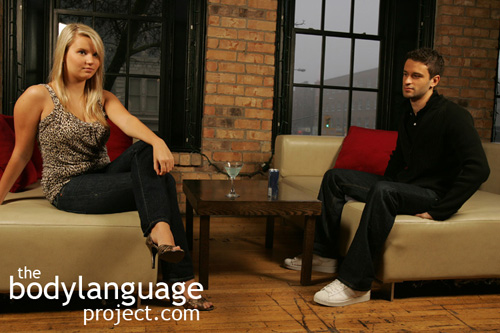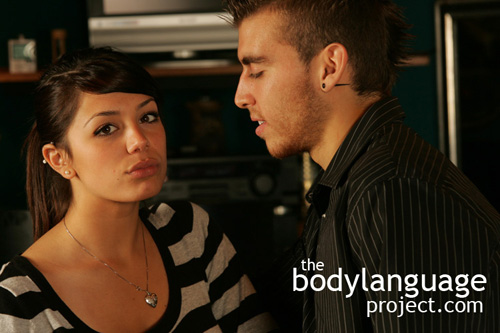The Hidden Meaning of Blading Body Language, Body Angling or Ventral Displays
 Cue: Blading Body Language, Body Angling or Ventral Displays
Cue: Blading Body Language, Body Angling or Ventral Displays
Synonym(s): Ventral Displays, Ventral Fronting, Ventral Denial, Ventral Distancing, Body Orientation, Body Angling, Seated Body Pointing, Turning The Body Away From Someone, Turning The Body Toward Someone, Chest Orientation, Facing Away, Facing Toward.
Description: The turning of the body, the shoulders and chest, either toward or away from stimuli.
In One Sentence: Bodies turn toward ideas and people they agree with, and turn away from ideas and people they disagree with.
How To Use it: The application of blading body language is simple in practice. To show or feign agreement simply turn your shoulders toward the speaker. To show or feign disagreement simply turn your shoulders away from the speaker. Feigning either condition can force other people to chase you, despite your general agreement. This can be effective in a dating context as your counterpart will work harder to placate your interests. This can also be effective in negotiations. Simply blade away to show that the offer advanced does not meet your conditions. Your “disinterest” will create an incentive to boost their offer in your favour.
Context: General.
Verbal Translation: a) “I like what I’m hearing so my body is angling toward you so we’re facing each other even more” b) “I don’t like what I’m hearing so my body is angling away from you so I can leave.”
Variant: Bodies might be angled or leaned in toward someone that is liked the most rather than for any form of agreement or disagreement.
Cue In Action: a) Jill turned her shoulders toward Bill when he paid her an honest compliment. b) When the much more successful associate, Frank arrived, Jill slowly turned away from Bill to focus her attention on Frank. After turning toward Frank, she made eye contact and began preening herself by fixing her hair. Her interest shifted from Bill to Frank which was obvious to onlookers by her shift in orientation.
Meaning and/or Motivation: Torsos house important vital organs that are responsible for keeping the body alive. Heart, lungs, liver, intestines and so forth are all easily accessible through a thin layer of skin, fat, muscle, ribs and a sternum and exposing our ventral side means that we trust we won’t be attacked and is therefore a signal of openness and liking. Ventral sides are usually oriented toward people we like and away from those we dislike.
Torsos will turn and angle away more and more as an encounter becomes more disagreeable. On the other hand, torsos will angle and turn toward as an encounter becomes more agreeable. When torsos face each other head-on, however, this can indicate direct confrontation or, contrarily, high intimacy (and engagement).
“Blading away” is to “turn the back on someone.” This demonstrates dislike, disagreement and disengagement.
“Blading toward” is to “turn to face someone.” This demonstrates liking, agreement and engagement.
Think of a knife, a “blade” that is turned on an angle so as to slice more or less sharply.
The greater the angle the greater the relative nonverbal meaning.
Cue Cluster: a) Ventral fronting or blading toward can be accompanied by leaning in to increase proximity, removing objects to create a clear view and various agreement indicators such as head nodding, eye contact, and touching. b) Ventral denial can appear with slouching, lean backward, orienting the torso away, or placing objects in front of the body such as clothing or books.
Body Language Category: a) Attentive, Courtship display, Liking, Indicators of sexual interest (IOsI), Intention movements, Orienting reflex or orienting response b) Barriers, Defensive, Dislike (nonverbal), Escape movements, Indicators of disinterest (IOD), Indicators of sexual disinterest (IOsD), Intention movements, Orienting reflex or orienting response.
Resources:
Allison, T., Puce, A., & McCarthy, G. (2000). Social perception from visual cues: role of the STS region. Trends in Cognitive Neurosciences, 4, 267–278.
Argyle, M., & Dean, I. Eye contact, distance and affiliation. Sociometry, 1965, 28, 289-304.
Boucher, Michael L. Holzberg, Jules D. (editor). Effect of seating distance on interpersonal attraction in an interview situation. Journal of Consulting and Clinical Psychology. 1972 38(1): 15-19.
Broth, Mathias and Lorenza Mondada. Walking Away: The Embodied Achievement of Activity Closings in Mobile Interaction. Journal of Pragmatics. 2013. 47: 41-58.
http://bodylanguageproject.com/articles/nonverbally-negotiate-conversation-walking-away/
Bania, Amanda E. ; Stromberg, Erin E. Call, Joseph (editor). The Effect of Body Orientation on Judgments of Human Visual Attention in Western Lowland Gorillas.
Journal of Comparative Psychology. 2013. 127(1): 82-90.
Belhiah, Hassan. Tutoring as an embodied activity: How speech, gaze and body orientation are coordinated to conduct ESL tutorial business. Journal of Pragmatics. 2009. 41(4): 829-841
Beaulieu, Catherine. Intercultural Study of Personal Space: A Case Study. Journal of Applied Social Psychology. 2004 34(4):794-805.
Baxter, James C., and Richard M. Rozelle (1975). “Nonverbal Expression as a Function of Crowding During a Simulated Police-Citizen Encounter.” In Journal of Personality and Social Psychology (Vol. 32, No. 1), pp. 40-54.
Cook, Mark. 1970. Experiments on orientation and proxemics. Human Relations 23 (1): 61-76.
Cacioppo, J. T., Hawkley, L. C., Crawford, L. E., Ernst, J. M., Burleson, M. H., Kowalewski, R. B., et al. (2002). Loneliness and health: Potential mechanisms. Psychosomatic Medicine. 2002; 64: 407-417.
Cook, M. Experiments on orientation and proxemics. Human Relations, 1970, 23, 61-67.
Clack, B., Dixon, J., & Tredoux, C. (2005). Eating together apart: Patterns of segregation in a multi-ethnic cafeteria. Journal of Community & Applied Social Psychology, 15, 1-16. doi:10.1002/casp.787
Castelli, Luigi ; Carraro, Luciana ; Pavan, Giulia ; Murelli, Elisa ; Carraro, Alessia. The Power of the Unsaid: The Influence of Nonverbal Cues on Implicit Attitudes. Journal of Applied Social Psychology. 2012 42(6): 1376-1393.
Coutts, Larrym. ; Ledden, Maribeth. Nonverbal Compensatory Reactions to Changes in Interpersonal Proximity. The Journal of Social Psychology. 1977 102(2): 283-290.
Dolphin, Carol Zinner. Beyond hall: Variables in the use of personal space in intercultural transactions. Howard Journal of Communications. 1988. 1(1): 23-38.
Eerland, Anita; Tulio M. Guadalupe; Ingmar H. A. Franken and Rolf A. Zwaan. Posture as Index for Approach-Avoidance Behavior. PLOS one. February 2012. 7(2): e31291.
http://bodylanguageproject.com/articles/approach-versus-avoidance-posture-in-nonverbal-body-language/
Friesen, C.K., & Kingstone, A. (1998). The eyes have it: Reflexive orienting is triggered by nonpredictive gaze. Psychonomic Bulletin and Review, 5, 490–493.
Felipe, N. Interpersonal distance and small group interaction. Cornell Journal of Social Relations, 1966, 1, 59-64.
Felipe, N. Connotations of seating arrangements. Cornell Journal of Social Relations, 1967, 2, 37-44.
Gifford, Robert ; O’Connor, Brian. Nonverbal intimacy: Clarifying the role of seating distance and orientation. Journal of Nonverbal Behavior. 1986 10(4): 207-214.
Gardin, Hershel ; Kaplan, Kalman J. ; Firestone, Ira J. ; Cowan, Gloria A. Lanzetta, John T. (editor). Proxemic effects on cooperation, attitude, and approach-avoidance in a Prisoner’s Dilemma game. Journal of Personality and Social Psychology. 1973. 27(1): 13-18.
George, N., Driver, J., & Dolan, R. J. (2001). Seen gaze-direction modulates fusiform activity and its coupling with other brain areas during face processing. Neuroimage, 13, 1102–1112.
Goodboy, Alan, K. and Maria Brann. Flirtation Rejection Strategies: Towards an Understanding of Communicative Disinterest in Flirting. The Quantitative Report. 2010. 15(2): 268-278.
http://bodylanguageproject.com/articles/how-to-reject-flirting-using-nonverbal-and-verbal-tactics/
Gunderson, Virginia M. ; Lockard, Joan S. Human postural signals as intention movements to depart: African data. Animal Behaviour. 1980 28(3): 966-967.
Greenberg, Carl I. ; Firestone, Ira J. Greenwald, Anthony G. (editor). Compensatory responses to crowding: Effects of personal space intrusion and privacy reduction. Journal of Personality and Social Psychology. 1977. 35(9): 637-644.
Graziano, Michael S.A. and Cooke, Dylan F. Parieto-frontal interactions, personal space, and defensive behavior. Neuropsychologia. 2006. 44(6): 845-859.
Hall, Edward T. (1963). “A System for the Notation of Proxemic Behavior.” In American Anthropologist (Vol. 65), pp. 1003-26.
Holt, Daphne J ; Cassidy, Brittany S ; Yue, Xiaomin ; Rauch, Scott L ; Boeke, Emily A ; Nasr, Shahin ; Tootell, Roger B H ; Coombs, Garth. Neural correlates of personal space intrusion. The Journal of neuroscience : the official journal of the Society for Neuroscience. 2014. 34(12): 4123-34.
Hietanen, J. K. (1999). Does your gaze direction and head orientation shift my visual attention? Neuroreport, 10, 3443–3447.
Hall, Jeffrey A. and Chong Xing. The Verbal and Nonverbal Correlates of the Five Flirting Styles. Journal of Nonverbal Behavior. 2015. 39:41–68. DOI 10.1007/s10919-014-0199-8
http://bodylanguageproject.com/articles/first-12-minutes-flirting-using-nonverbal-communication-study-reveals-26-body-language-cues-attraction/
Hietanen, Jari. Social attention orienting integrates visual information from head and body orientation. Psychological Research.2002 66(3): 174-179.
Haase, Richard F. ; Dimattia, Dominic J. Berdie, Ralph F. (editor). Proxemic behavior: Counselor, administrator, and client preference for seating arrangement in dyadic interaction. Journal of Counseling Psychology. 1970 17(4): 319-325.
IJzerman, Hans; Marcello Gallucci; Wim T.J.L. Pouw; Sophia C. Weigerber; Niels J. Van Doesum and Kipling D. Williams. Cold-Blooded Loneliness: Social Exclusion Leads To Lower Skin Temperatures. Acta Psychologica. 2012. 140:283-288. http://bodylanguageproject.com/articles/body-temperature-actually-drops-during-social-exclusion/
Koppensteiner, Markus ; Stephan, Pia ; Jäschke, Johannes Paul Michael. From body motion to cheers: Speakers’ body movements as predictors of applause. Personality and Individual Differences. 2015. 74: 182-185.
Kenner, Andrew N. ; Katsimaglis, George. Gender differences in proxemics: taxi-seat choice. Psychological Reports. 1993 72(2): 625(2).
Kaminski, Juliane ; Call, Josep ; Tomasello, Michael. Body orientation and face orientation: two factors controlling apes’ begging behavior from humans
Animal Cognition. 2004. 7(4): 216-223.
Kawashima, R., Sugiura, M., Kato, T., Nakamura, A., Hatano, K., Ito, K., Fukuda, H., Kojima, S., & Nakamura, K. (1999). The human amygdala plays an important role in gaze monitoring: A PET study. Brain, 122, 779–783.
Katza, Carmit; Irit Hershkowitz; Lindsay C. Malloya; Michael E. Lamba; Armita Atabakia and Sabine Spindlera. Non-Verbal Behavior of Children Who Disclose or do not Disclose Child Abuse in Investigative Interviews. Child Abuse & Neglect. 2012. 36: 12-20.
http://bodylanguageproject.com/articles/reading-nonverbal-behaviour-child-abuse-cases-encourage-children-divulge-information-truth-telling
Lockard, J.S. ; Allen, D.J. ; Schiele, B.J. ; Wiemer, M.J. Human postural signals: Stance, weight-shifts and social distance as intention movements to depart. Animal Behaviour. 1978 26: 219-224.
Langton, S. R. H. (2000). The mutual influence of gaze and head orientation in the analysis of social attention direction. The Quarterly Journal of Experimental Psychology, 53A, 825–845.
Langton, S. R. H., & Bruce, V. (1999). Reflexive visual orienting in response to the social attention of others. Visual Cognition, 6, 541–567.
Langton, S. R. H., & Bruce, V. (2000). You must see the point: Automatic processing of cues to the direction of social attention. Journal of Experimental Psychology: Human Perception and Performance, 26, 747–757.
Lawson, Rebecca P. ; Clifford, Colin W. G. ; Calder, Andrew J. About Turn: The Visual Representation of Human Body Orientation Revealed by Adaptation. Psychological Science. 2009. 20(3): 363(9).
Montgomery, Derek ; Moran, Christy ; Bach, Leslie. The influence of nonverbal cues associated with looking behavior on young children’s mentalistic attributions.
Journal of Nonverbal Behavior. 1996. 20(4): 229-249
Moore, Monica. Courtship Signaling and Adolescents: Girls Just Wanna Have Fun. Journal of Sex Research. 1995. 32(4): 319-328.
http://bodylanguageproject.com/articles/girls-just-want-to-have-fun-the-origins-of-courtship-cues-in-girls-and-women/
McBride, Glen, M. G. King, and J. W. James (1965). “Social Proximity Effects on GSR in Adult Humans.” In Journal of Psychology (Vol. 61), pp. 153-57.
Newman, Robert C. ; Pollack, Donald Holzberg, Jules D. (editor). Proxemics in deviant adolescents. Journal of Consulting and Clinical Psychology. 1973 40(1): 6-8.
Navarro, Joe. 2008. What Every BODY is Saying: An Ex-FBI Agent’s Guide to Speed-Reading People. William Morrow Paperbacks.
Okken, Vanessa ; Van Rompay, Thomas ; Pruyn, Ad. Room to Move: On Spatial Constraints and Self-Disclosure During Intimate Conversations. Environment and Behavior. 2013. 45(6): 737-760.
Remland, M. S. and T. S. Jones 1995. Interpersonal Distance, Body Orientation, and Touch: Effects of Culture, Gender, and Age. Journal of Social Psychology 135(3): 281-297.
Robinson, Jeffrey David. Getting Down to Business Talk, Gaze, and Body Orientation During Openings of Doctor-Patient Consultations. Human Communication Research. 1998. 25(1): 97-123.
Remland, Martins. ; Jones, Tricias. ; Brinkman, Heidi. Interpersonal Distance, Body Orientation, and Touch: Effects of Culture, Gender, and Age. The Journal of Social Psychology. 1995 135(3): 281-297.
Sartori, Luisa ; Becchio, Cristina ; Castiello, Umberto. Cues to Intention: The Role of Movement Information. Cognition. 2011. 119(2): 242-252.
Straube, Benjamin ; Green, Antonia ; Jansen, Andreas ; Chatterjee, Anjan ; Kircher, Tilo. Social cues, mentalizing and the neural processing of speech accompanied by gestures. Neuropsychologia. 2010. 48(2): 382-393.
Scherer, S. E., & Schiff, M. R. Perceived intimacy, physical distance, and eye contact. Perceptual and Motor Skills, 1973, 36, 835-841.
Scott, J. A. Comfort and seating distance in living rooms: The relationship of interactants and topic of conversation. Environment and Behavior, 1984, 16, 35-54.
Sommer, R. Studies in personal space. Sociometry, 1959, 22,247-260.
Sommer, R. The distance for comfortable conversation: A further study. Sociometry, 1962, 25, 111-116.
Sommer, R. Personal space: The behavioral basis of design. Englewood Cliffs, New Jersey: Prentice Hall. 1969.
Stern, Daniel and Estelle Bender (1974). “An Ethological Study of Children Approaching a Strange Adult.” In Richard Friedman et al. (Eds.), Sex Differences in Behavior (New York: John Wiley and Sons), pp. 233-58.
Uchino, B. N., Cacioppo, J. T., & Kiecolt-Glaser, J. K. (1996). The Relationship Between Social Support And Psychological Processes: A Review With Emphasis On Underlying Mechanisms And Implications For Health. Psychological Bulletin. 1996; 119: 488-531.
Underwood, M. K.. Glares of Contempt, Eye Rolls of Disgust and Turning Away to Exclude: Non-Verbal Forms of Social Aggression among Girls. Feminism & Psychology. 2004 14(3): 371-375
Wicker, B., Michel, F., Henaff, M.-A., & Decety, J. (1998). Brain regions involved in the perception of gaze: A PET study. Neuroimage, 8, 221–227.
Weiss, M., & Keys, C. The influence of proxemic variables on dyadic interaction between peers. Paper presented at the meeting of the American Psychological Association; Chicago, 1975, August.
Werner, Carol ; Brown, Barbara ; Damron, Gary Steiner, Ivan D. (editor). Territorial marking in a game arcade. Journal of Personality and Social Psychology. 1981. 41(6): 1094-1104.
Zeinstra, Gertrude G.; M.A. Koelen; D. Colindres ; F.J. Kok; C de Graaf. Facial Expressions in School-Aged Children are a Good Indicator of ‘Dislikes’, but not of ‘Likes.’ Food Quality and Preference. 2009. 20: 620-624.
http://bodylanguageproject.com/articles/read-kids-dislike-food-facial-expressions-accurate-detecting-dislike-not-like-children/








